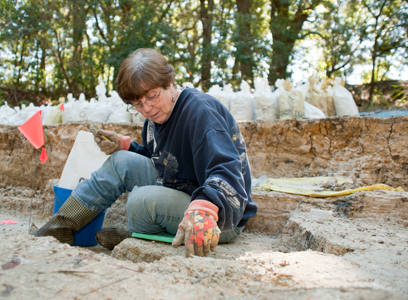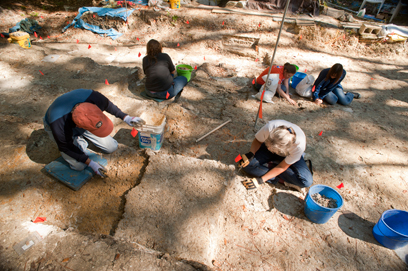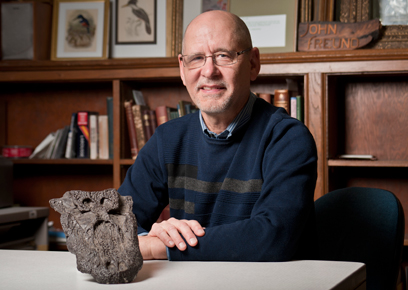For a few weeks each year, dozens of people stop their everyday activities to put on clothes they don’t mind getting dirty, drive to the middle of nowhere and dig in the dirt and mud for fossils.
Neither professional archaeologists nor paleontologists, the volunteers are like angels for the Florida Museum of Natural History, appearing when there is a need and enhancing the Museum’s collections in a way the staff could not manage alone.
“If it was just the few of us, we would only be able to collect a fraction of the specimens we do,” said Richard Hulbert, Florida Museum Vertebrate Paleontology collections manager. “The volunteers provide an invaluable service to the Museum.”
From Nov. 3 to 17, 2010, volunteers ventured to Thomas Farm, one of the richest fossil sites for terrestrial vertebrates in eastern North America. Located in Gilchrist County about 45 miles northwest of Gainesville, the site was accidentally discovered by a farmer in 1931.
The great diversity of species found there – from amphibians and reptiles to three-toed horses and bear-dogs – has led scientists to believe the 18.5-million-year-old site was an ancient sinkhole. As a result, bones discovered next to each other are often from different animals.
When volunteers go to the site each day, they are greeted by a Museum researcher managing the field. The researcher offers guidance, assigns each person 1 square meter of land to excavate and provides bags for specimens labeled with the diggers’ names. Volunteers are instructed to clear away small amounts of sediment with screwdrivers and dental picks, and to stay within their square, sometimes causing a buzz of “square envy.”

Photo by Kristen Grace
John Freund said he was initially skeptical about his assigned square when he first participated in a dig at Thomas Farm in 1999. He was instructed to work in an area away from the spot where everyone else was finding numerous fossils.
“They put me all alone, and I thought, ‘Oh great, I’m the new person, so they stick me down here where there isn’t anything,'” Freund said.
But within about an hour, Freund’s screwdriver hit a horse jaw at the edge of his square. After getting special permission to dig outside of his square to uncover the rest of the jaw, he ran into an alligator jaw, and soon after, unearthed a skull researchers did not recognize.
The specimen was jacketed with toilet paper – better known on-site as “paleo paper” – and sent back to Dickinson Hall to be prepared in the lab for research.
Eight years later, Freund received a plaque in the mail notifying him that the skull had been described as a new carnivorous weasel-like species and was named Zodiolestes freundi after the volunteer who had discovered it.
“I was very surprised,” said Freund, who keeps the plaque on his office wall in Smathers Library on the University of Florida campus.
And if that wasn’t enough, he struck gold again November 2010. Against all odds, he once again dug into a horse jaw at the edge of his square, asked to dig outside of his square to uncover the entire jaw, and ran into the second-ever skull of the rare carnivore Zodiolestes freundi.
“If you think about all the years they’ve been digging there and the hundreds of people who have found thousands of fossils, for me to find two of the same thing — the only examples of it — is just kind of unbelievable,” Freund said.

Photo by Kristen Grace
The newer specimen has more preserved teeth and will enable researchers to make comparisons to the first specimen, nearly doubling the legitimacy of the original observations, Hulbert said.
He was also amazed by the odds of one person discovering a new species twice.
“This is the reason sometimes people ask us, ‘Why do you keep going out there?'” Hulbert said.
Often hearing about the digs through Museum announcements, volunteers travel from locations outside of Gainesville for the opportunity to discover pieces of Florida’s past.
To attend the Thomas Farm dig Nov. 10, 2010, Susan and John Bell drove from McAlpin, a city near Live Oak, Fla. The first time they made the trip, the couple joked about calculating how far back in time they were driving.
“We would take our distance from home to the dig and figure out how many years per mile we were driving,” John said. “It was about 100,000 years per mile or something like that – it really was impressive.”
The fall 2010 excavation marked the retired couple’s third year participating in field trips with the Museum. They first heard about the opportunity from a newspaper advertisement, Susan Bell said. And now they have the bug.
“It’s like a treasure hunt,” said Susan, who uncovered a toe bone in 2010. “It’s fun because you find something almost every day.”
Dennis Appleby has participated in the Museum’s digs for about four years and goes on the field trips whenever Hulbert requests help. He enjoys meeting people from all backgrounds as well as “just going back to my dirt days,” he said. He uncovered the fossil he found most interesting at a site in Newberry a few years ago: the vertebrae of a giant sloth.
“When you find something like that, you figure, ‘I’m the first human to ever see that,’ ” Appleby said. “It’s just really neat.”

Photo by Kristen Grace
When large specimens are unearthed, they are protected with plaster jackets to prevent bones from breaking during the trip to the lab at Dickinson Hall, where researchers continue the preparation process. Meanwhile, bags of remaining sediment must be washed through screens to uncover microfauna, including bats, frogs, birds and rodents.
“The bottom line is that you don’t have a full picture of the past environment unless you compute everything,” said Art Poyer, a biological scientist in the Museum’s Vertebrate Paleontology Division. “In a year’s time, I might do 3 or 4 tons of sediment.”
Volunteers also help preparators clean and reassemble skeletons at Dickinson Hall. Suzanne Conner, who attended the Thomas Farm dig Nov. 10, 2010, said she started volunteering at the preparatory lab once a week in March 2010. Using water and small paintbrushes, she cleans dirt from the specimens, millimeter by millimeter.
“Once you’ve done that, you have a greater appreciation for it,” Conner said.
An amateur fossil collector for most of her life, Conner always wanted to be an explorer, “to fly airplanes and go to the darkest Africa,” she said.
A little closer to home, she participates in the digs held by the Florida Museum just to find out what’s next, she said.
“I don’t know what the appeal is, it’s just the discovery, I think,” Conner said. “We like digging in the dirt.”
Learn more about the Thomas Farm at the Florida Museum.